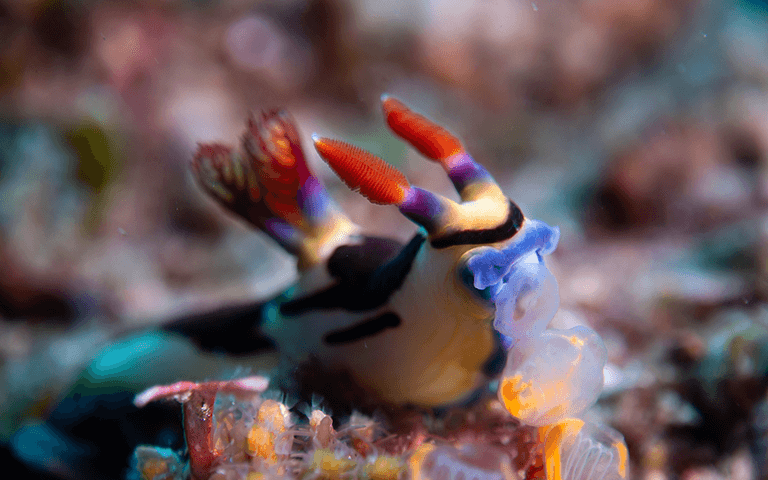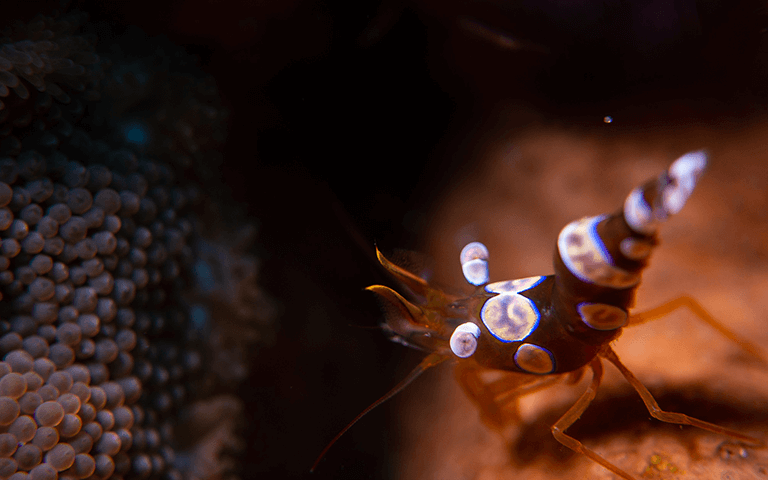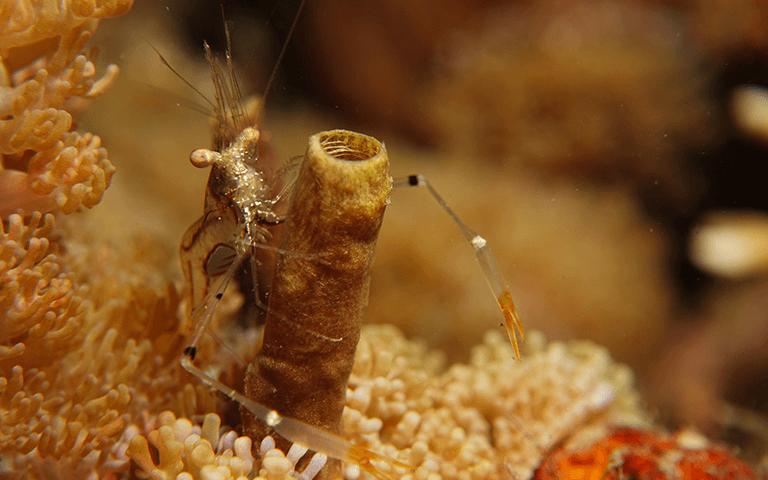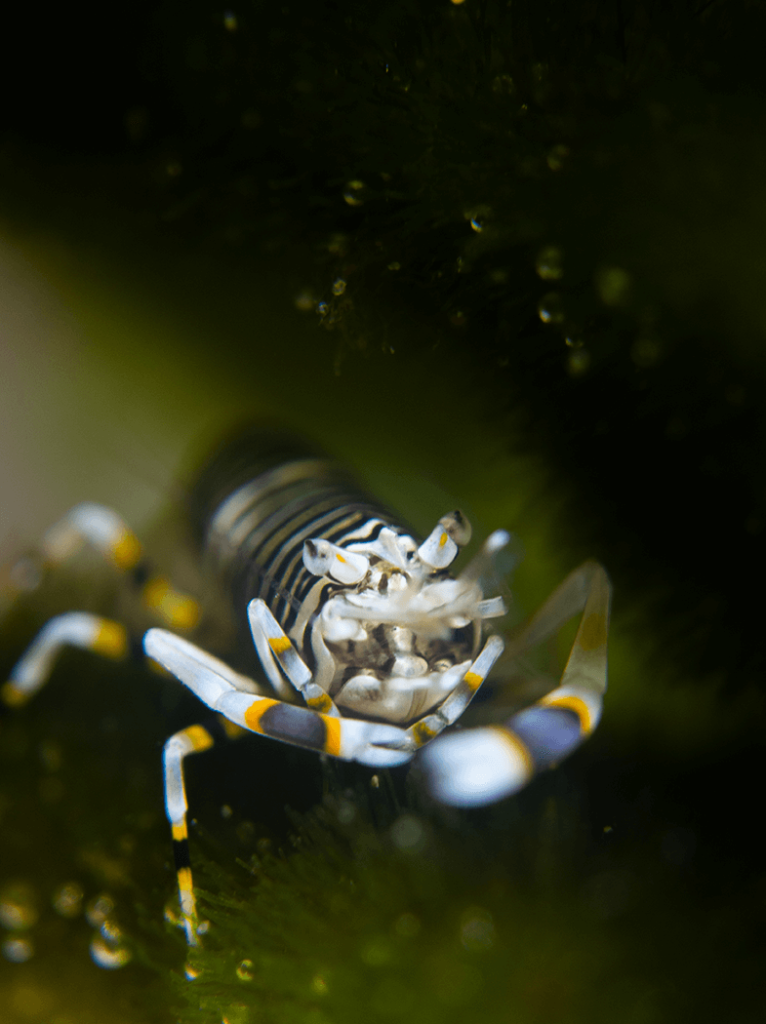by Megan Whitehead
Have you ever noticed that while you and your dive group are obsessing about sharks swimming by, your dive guide is getting excited over a boring rock, or some sand patch? Do you ever wonder why? Chances are, they’ve spotted a macro creature!
Macro actually means BIG
Underwater photographers use it to refer to the most minuscule creatures because they use a macro lens to get a big, close-up picture of this marine critter. Macro is now an extremely popular term around the greater diving community for divers that like to focus less on the big creatures, and more on the weird and wonderful little ones.
When people first learn to dive, many struggle to maintain buoyancy so the easiest animals to spot are often the big ones. Once divers master their buoyancy, they might still be attracted to big animals and the challenge of diving in currents, but at some point, diving starts to turn into a life-size game of “I Spy.” Especially when divers start travelling around the world, since macro creatures can vary wildly from ocean to ocean.
When people first learn to dive, many struggle to maintain buoyancy so the easiest animals to spot are often the big ones. Once divers master their buoyancy, they might still be attracted to big animals and the challenge of diving in currents, but at some point, diving starts to turn into a life-size game of “I Spy.” Especially when divers start travelling around the world, since macro creatures can vary wildly from ocean to ocean.
While many divers find a plethora of marine life in the deep blue and on the reefs, what macro enthusiasts discover “in the muck” is what captures the interest of experienced divers. Underwater photographers and marine biologists love to spot these beautiful little critters.


Finding colourful macro surprises in unexpected places
To have a keen eye for spotting tiny things, one needs to master not just buoyancy, but also fish ID and environmental awareness. Knowing the habitat of tiny creatures is a surefire way to make it easier to find them. Imagine looking for a needle in a haystack without knowing which haystack to look in. Even when you find a rare species, maybe even one you’ve never seen before, part of the fun is taking out the Fish ID book and cataloging your personal library of finds.


Gili Air has the best of both worlds
The Gili islands sit on reef shelves and are bordered by great deep sea. It creates a fantastic environment to see anything from the epic macro to turtles, sharks, and occasionally even whales! Now, real talk, you never know what you are going to see on a dive. You’re diving in a wild, natural habitat — it’s not an aquarium. Because of the many different reefs around our islands, diving in the Gilis has become known for the tiny treasures that you really have to search for. Yes, we’re talking about nudibranchs and other macro creatures!
The Gilis offer a huge variety of fish, albeit in smaller numbers and sizes. But the vast diversity is incredible! When you look closely, you will start to notice familiar markings of your favorite fish and start to uncover camouflaged fish you hadn’t even noticed before. There are many stonefish, cuttlefish, octopus, boxfish, and tiny pufferfish!
The Gilis offer a huge variety of fish, albeit in smaller numbers and sizes. But the vast diversity is incredible! When you look closely, you will start to notice familiar markings of your favorite fish and start to uncover camouflaged fish you hadn’t even noticed before. There are many stonefish, cuttlefish, octopus, boxfish, and tiny pufferfish!
Did you know that Indonesia is a perennial winner in Scuba Diving magazine’s annual Top 100 Readers’ Choice Awards in the macro animal category? In fact, The Gili Islands are home to some of the most compelling macro spots within the Indonesian archipelago.
The Gili Islands offer a number of sites on shallow, gently sloping reefs and sand — the perfect type of sites to spot any type of macro. On Han’s Reef and Bounty Wreck, divers spend their time looking for mimic octopus, blue ring octopus, and flamboyant cuttlefish. Not many divers can boast that they’ve seen 20 different nudibranchs on a single dive, but that is not uncommon while diving any of the sites around the Gilis.
The Gili Islands offer a number of sites on shallow, gently sloping reefs and sand — the perfect type of sites to spot any type of macro. On Han’s Reef and Bounty Wreck, divers spend their time looking for mimic octopus, blue ring octopus, and flamboyant cuttlefish. Not many divers can boast that they’ve seen 20 different nudibranchs on a single dive, but that is not uncommon while diving any of the sites around the Gilis.


Mix up your dive guides for more macro
Each instructor and divemaster has their own style. While you don’t often get to choose your dive guide, if you dive over the course of a week, you will likely be able to dive with a few different guides. This is a great opportunity to observe and learn how they dive and what they look for.
It takes a fair amount of time to be able to adjust your eyes and slow down enough to search for macro. This is why we have dive professionals and local guides that do much of the hard part for you! (Work smarter, not harder right?)
It takes a fair amount of time to be able to adjust your eyes and slow down enough to search for macro. This is why we have dive professionals and local guides that do much of the hard part for you! (Work smarter, not harder right?)
One of our local guides, Oleng, tells divers that one thing you really need to do is slow down. Float, float, and float some more. Not only will this help with your air consumption, but this will allow you to really look at the reef and coral to find elusive macro creatures. One of Oleng’s talents is spotting Meno Wall’s local pygmy seahorse! This seahorse is no bigger than your fingernail! For those divers that haven’t visited us yet, Meno Wall is a dive site off of… yeah, you guessed it — Gili Meno.
Not sure exactly what epic creature you saw underwater? This is another thing that our guides (or our Fish ID course) are good for. In the debrief after your dive, crack open that fish ID book!
Not sure exactly what epic creature you saw underwater? This is another thing that our guides (or our Fish ID course) are good for. In the debrief after your dive, crack open that fish ID book!
Macro Dive the Gili Islands with the 3W tribe
Large marine animals may be thrilling, often giving you a feeling that teeters between excitement and fear. To see something larger than yourself grants you a different perspective. On the flip side, to see something so impossibly small, something that non-divers could never dream of, makes you feel larger than life.
Come visit the Gilis and the 3W Tribe for perfect diving conditions to discover a plethora of macro creatures!
Come visit the Gilis and the 3W Tribe for perfect diving conditions to discover a plethora of macro creatures!
